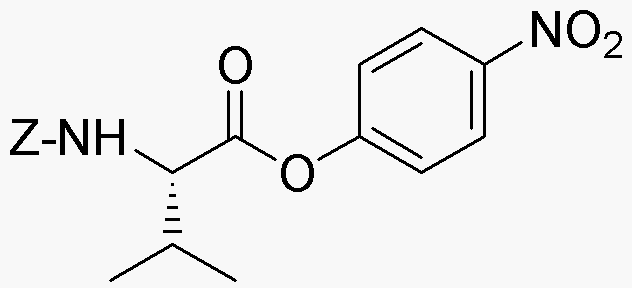Z-L-valine 4-nitrophenyl ester is widely utilized in research focused on:
- Peptide Synthesis: This compound serves as a valuable building block in the synthesis of peptides, aiding researchers in developing new therapeutic agents.
- Drug Development: It plays a crucial role in the pharmaceutical industry for creating prodrugs, enhancing the bioavailability of active pharmaceutical ingredients.
- Bioconjugation: The ester functionality allows for efficient conjugation with biomolecules, facilitating the development of targeted drug delivery systems.
- Analytical Chemistry: Used as a standard in chromatography, it helps in the quantification of amino acids and related compounds in various samples.
- Research in Enzyme Activity: This compound is employed in studies to evaluate the activity of enzymes that hydrolyze ester bonds, providing insights into enzymatic mechanisms.
General Information
Properties
Safety and Regulations
Applications
Z-L-valine 4-nitrophenyl ester is widely utilized in research focused on:
- Peptide Synthesis: This compound serves as a valuable building block in the synthesis of peptides, aiding researchers in developing new therapeutic agents.
- Drug Development: It plays a crucial role in the pharmaceutical industry for creating prodrugs, enhancing the bioavailability of active pharmaceutical ingredients.
- Bioconjugation: The ester functionality allows for efficient conjugation with biomolecules, facilitating the development of targeted drug delivery systems.
- Analytical Chemistry: Used as a standard in chromatography, it helps in the quantification of amino acids and related compounds in various samples.
- Research in Enzyme Activity: This compound is employed in studies to evaluate the activity of enzymes that hydrolyze ester bonds, providing insights into enzymatic mechanisms.
Documents
Safety Data Sheets (SDS)
The SDS provides comprehensive safety information on handling, storage, and disposal of the product.
Product Specification (PS)
The PS provides a comprehensive breakdown of the product’s properties, including chemical composition, physical state, purity, and storage requirements. It also details acceptable quality ranges and the product's intended applications.
Certificates of Analysis (COA)
Search for Certificates of Analysis (COA) by entering the products Lot Number. Lot and Batch Numbers can be found on a product’s label following the words ‘Lot’ or ‘Batch’.
*Catalog Number
*Lot Number
Certificates Of Origin (COO)
This COO confirms the country where the product was manufactured, and also details the materials and components used in it and whether it is derived from natural, synthetic, or other specific sources. This certificate may be required for customs, trade, and regulatory compliance.
*Catalog Number
*Lot Number
Safety Data Sheets (SDS)
The SDS provides comprehensive safety information on handling, storage, and disposal of the product.
DownloadProduct Specification (PS)
The PS provides a comprehensive breakdown of the product’s properties, including chemical composition, physical state, purity, and storage requirements. It also details acceptable quality ranges and the product's intended applications.
DownloadCertificates of Analysis (COA)
Search for Certificates of Analysis (COA) by entering the products Lot Number. Lot and Batch Numbers can be found on a product’s label following the words ‘Lot’ or ‘Batch’.
*Catalog Number
*Lot Number
Certificates Of Origin (COO)
This COO confirms the country where the product was manufactured, and also details the materials and components used in it and whether it is derived from natural, synthetic, or other specific sources. This certificate may be required for customs, trade, and regulatory compliance.


